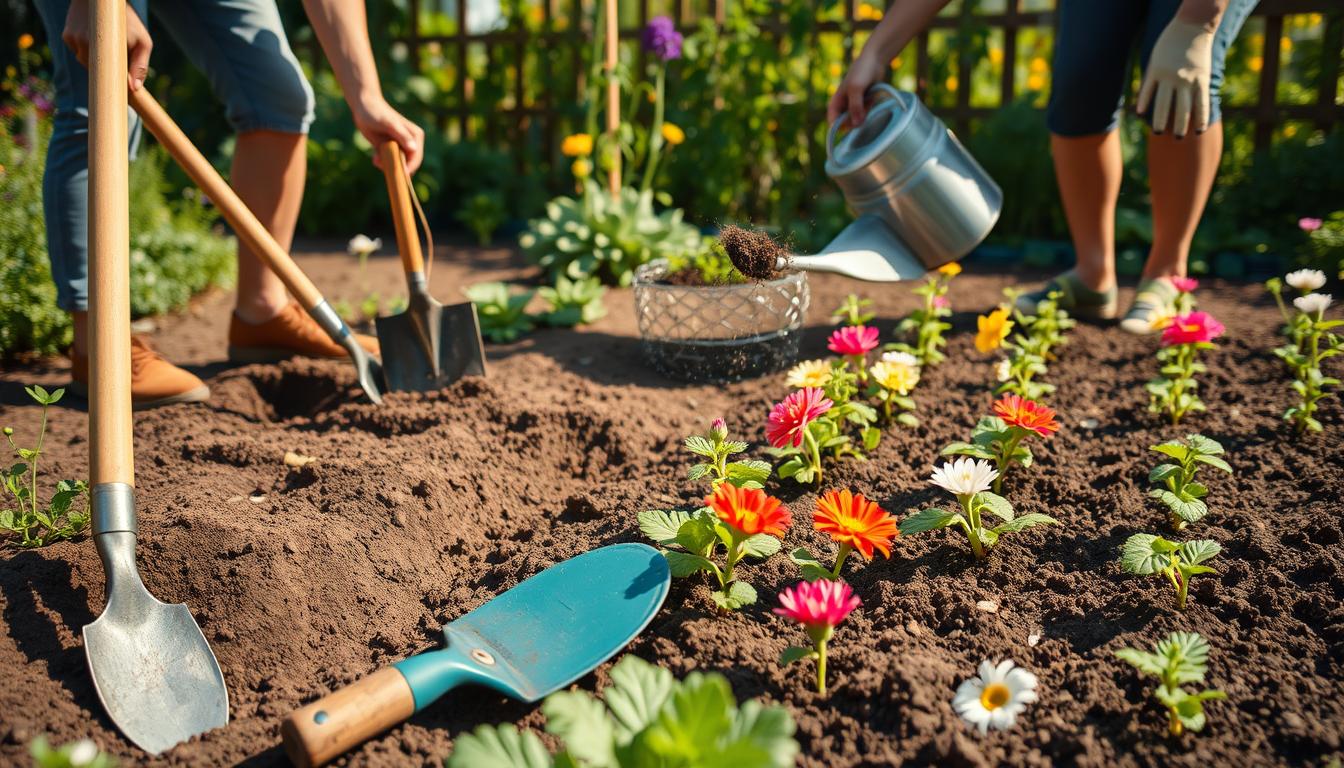Welcome to my guide on basic gardening for beginners. I’ll share tips to help you start. Gardening is a great hobby that lets you connect with nature and grow your own food. It also offers the joy of nurturing plants.
I’ll show you how to create a thriving garden, no matter the size of your space. This guide will teach you the skills needed to begin your gardening journey. You’ll learn how to make the most of your outdoor area.
In this guide, I’ll give you beginner tips and easy methods to succeed. By using these techniques, you’ll create a beautiful garden. It will bring you joy and fulfillment.
Understanding the Basics of Gardening
Gardening is a rewarding hobby that needs knowledge, skills, and patience. It’s about creating a thriving garden. You must prepare the soil, choose the right plants, and care for them properly. These steps are key to a successful garden.
Gardening offers many benefits. It lets you grow your own food and connect with nature. It also improves your mental and physical health and makes your outdoor space look better. Learning essential gardening skills like pruning and soil management will help you create a beautiful garden.
What is Gardening?
Gardening is about growing plants like fruits, vegetables, flowers, and trees. It involves preparing the soil, planting seeds, and keeping plants healthy. By using simple tricks and mastering basic practices, you can create a garden that brings joy and satisfaction.
Benefits of Gardening
Gardening has many benefits. Some of the most important ones are:
- Improved mental and physical health
- Increased food security
- Enhanced aesthetic appeal
- Opportunities for social connection and community building
Common Gardening Terms
As you start gardening, it’s important to know common terms. These include soil quality, irrigation, and pruning. Understanding these will help you make better decisions for your garden and ensure its success.
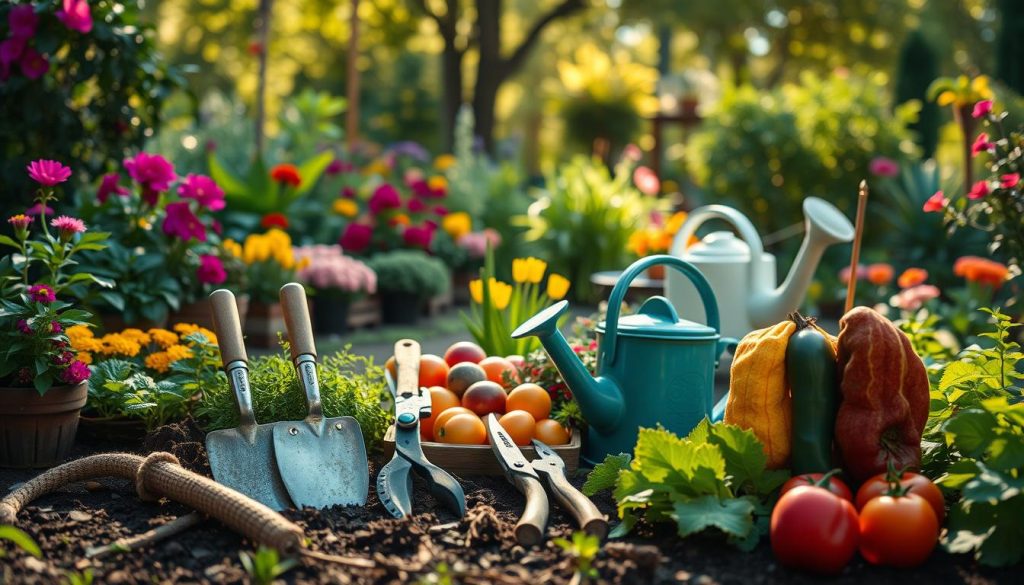
Choosing the Right Location for Your Garden
Starting a garden for beginners means learning key horticulture techniques. One important step is picking the right spot. This involves checking sunlight and soil quality. Most plants need at least 6 hours of direct sunlight daily. Some can handle partial shade.
Understanding how to care for plants is crucial. This knowledge helps your garden grow well.
To find the best spot, think about these things:
- Sunlight: Most plants need at least 6 hours of direct sunlight daily
- Soil quality: Check the pH level and nutrient content of your soil
- Wind protection: Pick a spot that shields plants from strong winds
Soil quality is also key. It decides which plants you can grow and how well they’ll do. By learning about horticulture and plant care, you can make a garden that’s full of life. This garden will give you fresh food and beautiful flowers.
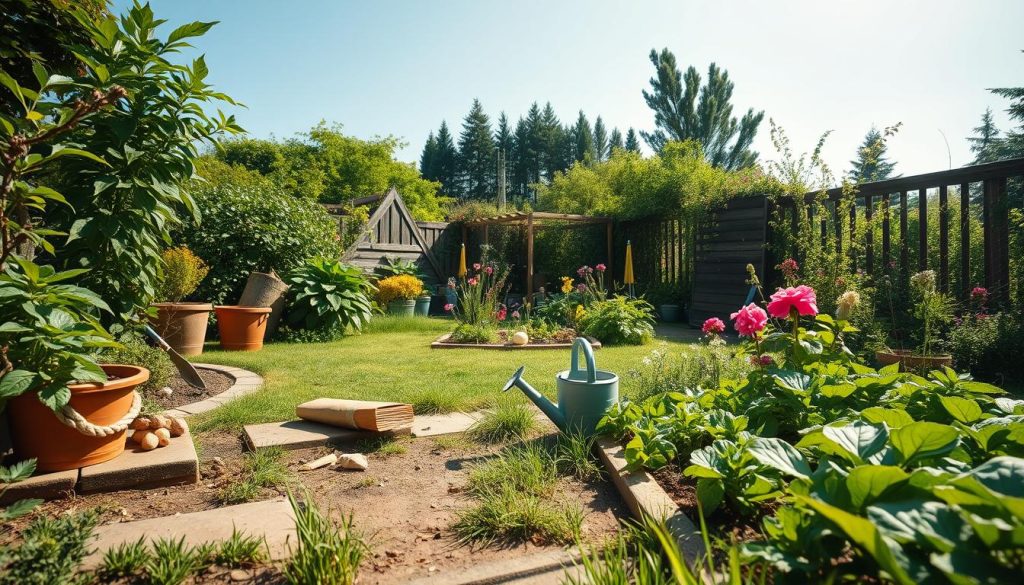
| Soil Type | pH Level | Nutrient Content |
|---|---|---|
| Clay | 6.0-7.0 | High nutrient content |
| Sandy | 6.0-7.0 | Low nutrient content |
| Loamy | 6.0-7.0 | Medium nutrient content |
Selecting the Right Plants for Your Garden
Choosing the right plants is key to a thriving garden. As a beginner, knowing the basics is crucial. Native plants are a great choice because they fit well with local weather and soil.
They need less care and fight off pests and diseases easily. This makes them perfect for beginners.
Exotic plants, on the other hand, can be tricky to grow. But they bring a unique flair and color to your garden. Pairing plants together, called companion planting, is a smart move. It helps plants grow well together and keeps pests away.
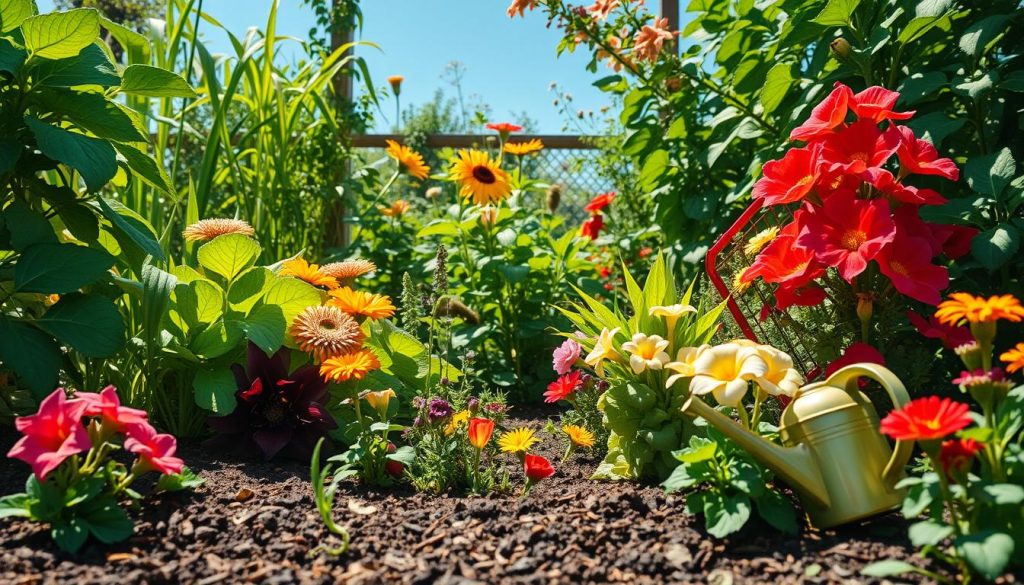
Seasonal planting is also important. Plants grow best at different times of the year. Spring is great for bulbs and perennials, while summer is for warm-season crops.
By using these tips and understanding gardening basics, you can make a beautiful garden. It will bring you joy and satisfaction.
| Season | Plant Type | Basic Gardening Techniques |
|---|---|---|
| Spring | Bulbs and Perennials | Companion planting, mulching |
| Summer | Warm-season crops | Companion planting, irrigation |
| Fall | Cool-season crops | Companion planting, composting |
| Winter | Evergreen plants | Pruning, mulching |
Preparing Your Garden Bed
To have a thriving garden, start with a well-prepared bed. It’s more than digging a hole and planting seeds. Remove weeds and debris to make a smooth surface for your plants.
Knowing how to prepare the soil is key. This includes choosing the right tools. Shovels, rakes, and tillers are essential for removing rocks and aerating the soil.
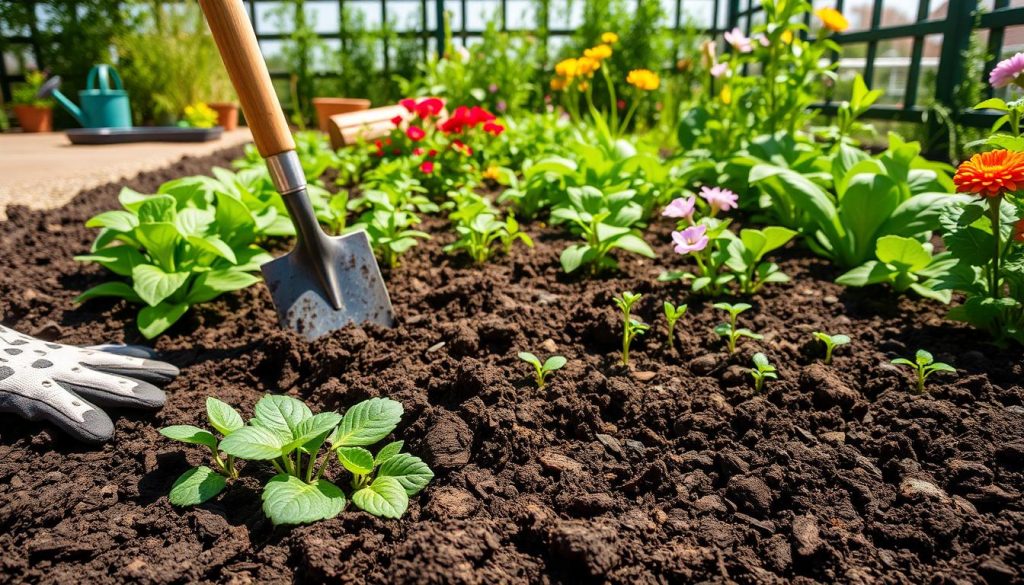
There are several garden bed types to consider. Raised beds are good for poor soil or drainage. Container gardens are ideal for small spaces or specific plants. In-ground gardens are traditional and customizable.
By understanding these types and using simple tricks and skills, you can create a beautiful garden. It will bring you joy for years.
Watering Techniques for Thriving Plants
Exploring horticulture, I’ve learned watering is key in gardening. For beginners, knowing how to water is crucial. It’s what makes plants grow well.
Watering depends on the plant, soil, and weather. Too much water harms plants, while too little stresses them. To water right, consider these:
- Soil quality: Check the soil’s moisture by feeling it with your finger. If it’s dry, it’s time to water.
- Plant type: Each plant needs different water amounts. Learn what your plants need.
- Climate: Weather affects how much water plants need.
Drip irrigation is great for watering plants. It saves water by giving it directly to the roots. This method helps plants grow strong and healthy.
Soil Health: The Foundation of Good Gardening
Exploring gardening, I see that soil health is key. Knowing gardening basics and using simple methods can greatly improve soil. This leads to a healthy garden.
Understanding Soil Types
Soil comes in three main types: clay, silt, and sand. Each has its own needs. For instance, clay soil holds water too well, while sandy soil dries out fast.
Improving Soil Fertility
To make soil better, I mix compost, manure, and fertilizers. These steps add nutrients and balance the soil. Here are some tips:
- Add organic matter like compost or manure
- Choose fertilizers that fit my soil type
- Rotate crops to keep the soil healthy
| Soil Type | Characteristics | Management Techniques |
|---|---|---|
| Clay | Dense, prone to waterlogging | Add organic matter, use drainage systems |
| Silt | Medium texture, prone to erosion | Use mulch, practice contour planting |
| Sand | Coarse texture, prone to dryness | Add organic matter, use irrigation systems |
Pest Management in the Garden
As I learn more about gardening, I see how important pest management is. It keeps my garden healthy and growing well. I’ve found that knowing common pests and using basic gardening practices help a lot.
Recognizing Common Garden Pests
Some pests like aphids, whiteflies, and slugs can harm plants a lot. It’s key to spot these pests early and act fast. Here are signs to watch for:
- Aphids: curled or distorted leaves, sticky substance on leaves or stems
- Whiteflies: small, winged insects flying around plants, yellowing or stunted leaves
- Slugs: holes in leaves, slimy trails on leaves or soil
Organic Pest Control Options
There are many ways to control pests without harming the environment. Options like neem oil, diatomaceous earth, and companion planting work well. Here’s a quick guide:
| Pest Control Method | Description |
|---|---|
| Neem Oil | A natural insecticide that can be used to control a wide range of pests |
| Diatomaceous Earth | A powder made from fossilized algae that can be used to control slugs and other pests |
| Companion Planting | Planting certain plants together to repel pests or attract beneficial insects |
Seasonal Gardening Tips
Starting a garden is exciting, but knowing seasonal tips is key. These tips help your garden grow all year. By using basic gardening techniques, you can make your garden beautiful and productive.
It’s important to think about the weather when gardening. In spring, focus on getting your soil ready and picking the right plants. You also need to care for your plants, like watering and pruning, to help them grow.
Spring Planting Strategies
- Prepare the soil by adding organic matter and fertilizers
- Choose plants that are suitable for the spring season, such as bulbs and perennials
- Provide adequate care, including watering and pruning, to ensure healthy growth
Preparing for Winter
To get ready for winter, protect your plants from cold and harsh weather. Use mulch, prune trees, and consider using cold frames. These steps help your garden stay healthy and productive all year.
| Season | Gardening Tips |
|---|---|
| Spring | Prepare soil, plant bulbs and perennials, provide adequate care |
| Winter | Protect plants from frost, provide mulch, prune trees and shrubs |
Maintaining Your Garden
To keep your garden thriving, following key gardening principles is crucial. This includes regular maintenance. Techniques like pruning and deadheading promote healthy growth and blooming. Easy gardening methods help keep your garden’s shape and beauty.
Some essential tasks for your maintenance routine are:
- Pruning plants to maintain shape and promote healthy growth
- Deadheading flowers to encourage repeat blooming and prevent seed production
- Weeding to prevent competition for water and nutrients
Using mulch, hand-weeding, and herbicides are effective weeding strategies. These easy gardening methods help keep your garden looking its best. Always follow key gardening principles, like proper pruning and deadheading, to keep your garden thriving.
By following these basic gardening techniques and adding them to your routine, you’ll enjoy a beautiful garden all season. Whether you’re experienced or new to gardening, maintaining your garden is an ongoing task. It requires attention to detail and a commitment to using key gardening principles.
Harvesting Your Garden’s Bounty
Harvesting your garden’s fruits (or veggies) is the most rewarding part. Knowing when to pick depends on the plant type. Some are ready when they grow to a certain size, while others need a specific color or texture.
Use the right harvesting methods to keep your produce fresh and tasty. Gently take items off the plant with clean, sharp tools. This way, you avoid damaging the plant or your hands.
Proper storage is key. You can refrigerate, can, freeze, or dry your harvest. With a bit of care, you can enjoy your gardening efforts all year.
Gardening is a lifelong passion that connects you with nature. It lets you grow your own food and feel proud of your foundational gardening practices. Whether you’re new or experienced, there’s always more to learn.
I hope this guide has given you the knowledge and inspiration to start your own garden. Happy planting!

